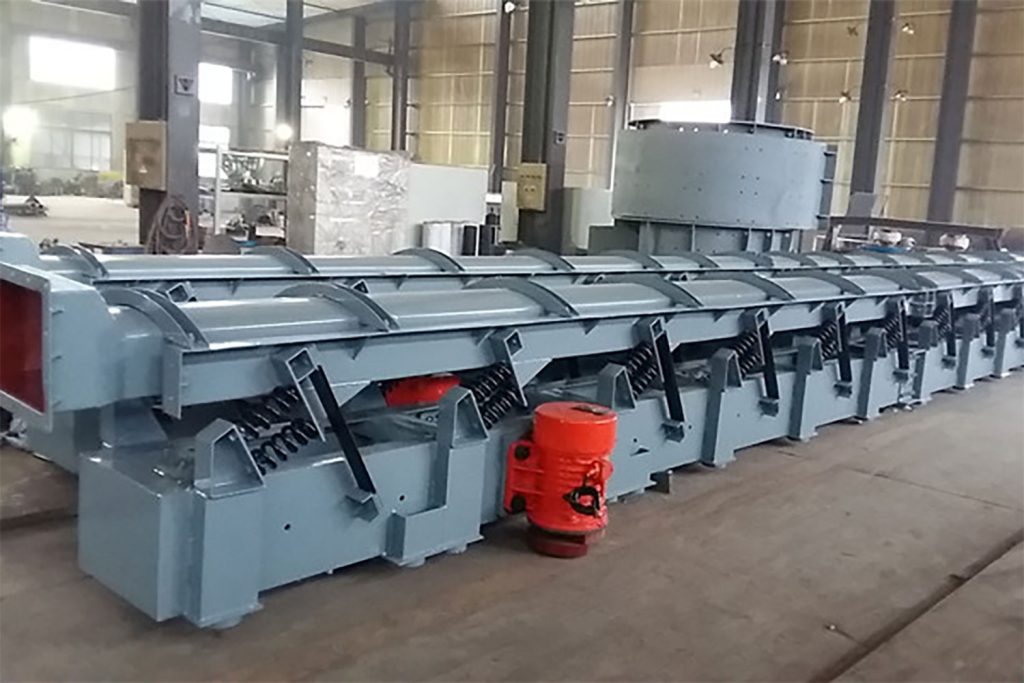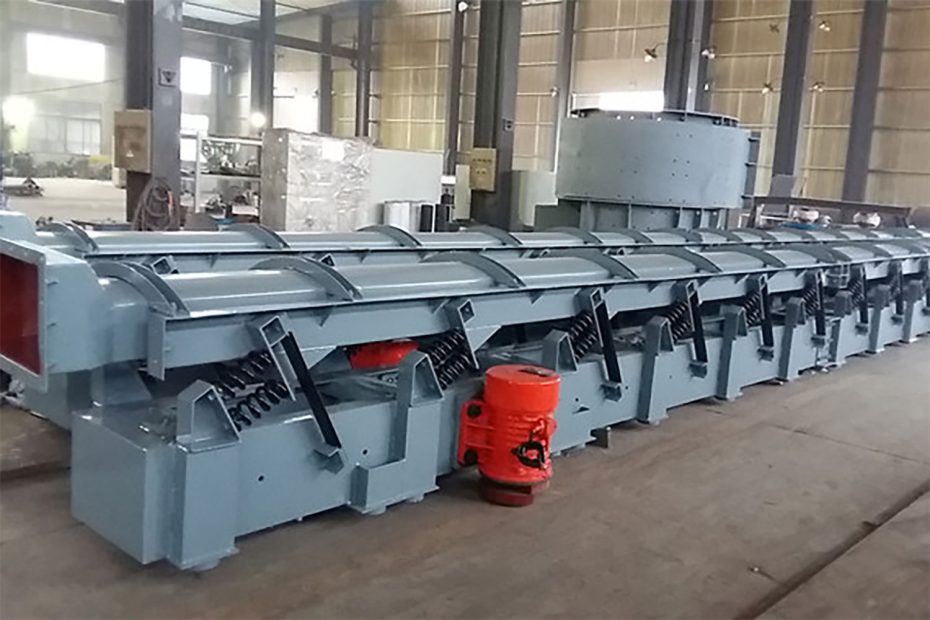What is a vibrating conveyor
A vibrating conveyor is a piece of equipment to convey objects by vibration literary, is robust conveying equipment used for fine to coarse-grained bulk materials. The objects are moved forwards not by vertical vibration but by vibration in the same direction as the moving direction. They are extremely durable provided, the only limitation results from the suspension design.
The vibrating conveyor has several characteristics that other conveyors don’t have, and hard to be broken and easy to maintain after being introduced. However, its price is slightly more expensive compared with other conveyors.

About characteristics of a vibratory conveyor.
The structure is simple
Conveyed objects move forwards just by transferring vibration to the trough (casing) that conveyed objects go through. The transferred vibration is generated by a vibrating motor (vibrator) or combination of general-purpose motors and crankshafts. Its structure is made to be simple.
Conveyed objects are not limited
Since the trough (casing) in which conveyed objects go through is normally made of steel plate, this type of conveyor covers a wide range of types of carried materials such as high-temperature materials, high abrasion-resistant materials, easily corroded materials, hard materials, and a certain degree of adhesive materials. One of the reasons for this characteristic is flexibility which makes the Vibrating Conveyor possible to cope with various types of materials by using stainless steel trough, lining the inside of the trough, and putting a lid on the trough to seal up, and so on.
Clean convey
There is no dropping of carrying materials at the turning back point of belts like a belt conveyor. Scattering of the carrying materials can be prevented by putting a lid on the trough and sealing it up. Also, even trough is sealed up, cleaning is easily done by taking the lid off and the trough can be kept clean since there are no blades like screw conveyors or other obstacles and the trough is empty. It seems to be one of the reasons that Vibrating Conveyor using stainless steel trough is selected in food plants is cleanliness.
Energy saving
Electricity consumption can be kept less since Vibrating Conveyor often can convey large amounts of materials with small motors. Of course, the proper size of the motor needs to be selected depending on the types and amounts of the conveying materials.
Easy for maintenance and inspection
A small number of parts are consumed by spinning or being rubbed and malfunction rarely occurs. Maintenance is easy after being introduced since the number of component parts is small and the number of inspection positions is also small.
How it works
The vibrating conveyor moves upwards at a sinusoidal angle in the direction of transport. With each forward feed, it lifts the material depending on the cast parameter and pushes it in the desired direction. During reverse, the material remains motionless due to its inertia and the downwards direction of the conveyor.
With every additional forward vibration, the material is inched continually forwards. This process is repeated depending on the frequency of the vibratory drive. The speed of the material feed is determined by the amplitude range and the frequency of the conveyor’s vibrations.
Vibrating conveyors with unbalanced drive
The unbalance motors used for vibrating conveyors are generally maintenance-free, three-phase motors. Adjustable unbalance weights are attached to both shaft ends.
The amplitude of these vibrating conveyors is changed by manually adjusting the imbalance. The frequency is determined by the rotational speed.
To achieve the desired linear vibration, two counteracting drives are required. An individual motor would cause a circular motion.
How do vibratory and shaker conveyors work?
The vibratory conveyors work by pulsing an electromagnetic drive vibrating the conveyor tray using leaf springs, transferring the product stream along with the upper conveyor tray. The linear action vibratory drives can be used for various complementary functions, including heating, cooling, grading, feeding, settling, air knife applications, vacuum extraction, weighing, and packing, to name but a few.
The majority of the e-mag vibration conveyors have an open design rectangular pan, and our drives can be located in a variety of positions, including underslung. The leaf springs/fixtures are attached to the conveyor’s mounting blocks; generally, side situated for easy access. The type of leaf spring used is dependent upon the product, conveyor size, and throughputs.
What are the main vibration conveyor applications?
In most cases, vibrating conveyors can be used in place of belt conveyors for hygienic handling of products, processes, or food streams. The industries where they are most used are food production, pet food production, and pharmaceuticals, where the machinery needs to be easily cleaned with no places for bacteria to accumulate.
What are the differences between a BELT conveyor and a vibratory conveyor?
A vibratory conveyor uses an electromagnetic drive to vibrate the product along the conveyor to the following processing stage. A belt conveyor uses a belting type material, mechanical motor driven with all of the associated maintenance that goes with a belt conveyor system.
Belt conveyors do not disperse or settle product, and if loaded in a ‘pyramid’ at one end, it will remain a ‘pyramid’ whilst being transported to the end of the belt conveyor. Vibratory conveyors disperse, spread, even feeds, align, and grade into fractions, to name but a few feasible applications.
Belt conveyors have a low initial purchase cost, usually 30% lower. However, the maintenance cost is much higher as there are more parts to replace on belt conveyors. On vibrating conveyors, the trays do not need to be replaced (unlike belting materials). It is usually more economical to use a vibrating conveyor as they have a lower cost of ownership.
